
Meade and Antares Focal Reducers
Last updated: 28 October 2008
This is an update to my previous Meade and Antares Focal Reducers report. That initial report was based on usage with the 8" LX90-ACF. This update is based on usage with the 8" LX200-ACF. See the earlier report for unpacking and first use details.
All of the visual and photograph tests reported here were with an OPT 2" star diagonal attached to the Meade Microfocuser. Here you can see that there is essentially no clearance available from the mount base when using the Microfocuser:
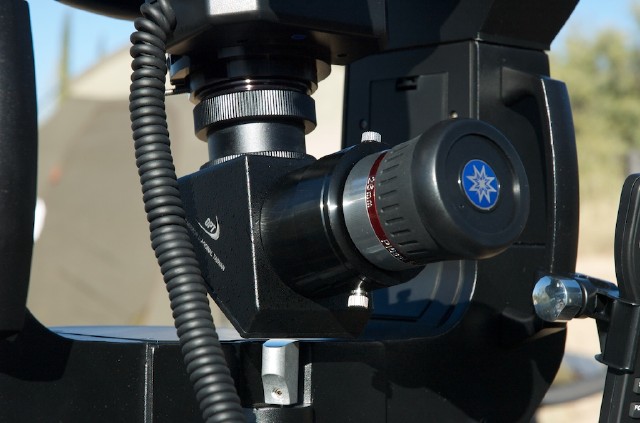
The star diagonal would touch the mount base when the telescope was pointed to an altitude of about 82°. Without the Microfocuser in place, there would be no clearance problem, with or without a focal reducer attached.
Using the attachment adapters included with the Meade Microfocuser (standard with the 8" LX200-ACF), I could only attach the OPT 2" star diagonal (which uses a SCT port thread) at the eyepiece end of the Microfocuser. To use the Meade 1.25" star diagonal that came with the LX200-ACF, it would have been necessary to detach the Microfocuser from the telescope and change the adapters. However the Microfocuser could not be removed by just unscrewing the entire assembly from the telescope rear port, as it would hit the manual focuser knob on the back of the OTA. It would have been necessary to unscrew three setscrews on the Microfocuser to remove the Microfocuser. As a result I did not test the focal reducers with the 1.25" star diagonal.
Here you can see the Meade f/6.3 Series 4000 Focal Reducer/Field Flattener ($129 from OPT) attached between the Microfocuser and the 2" star diagonal. In this configuration, the maximum altitude would be about 75°.
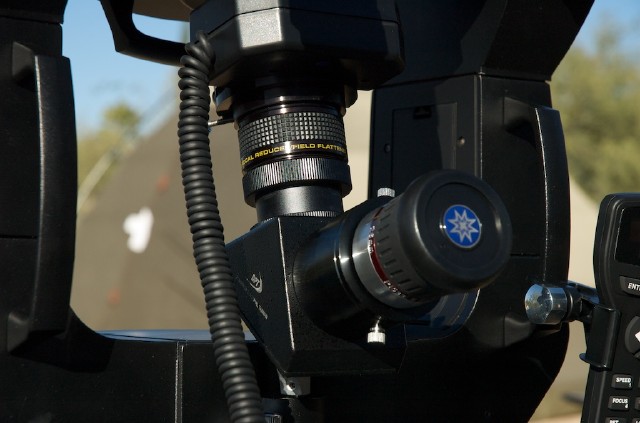
Here you can see the Antares f/6.3 SCT Reducer/Corrector ($99 from OPT) attached between the Microfocuser and the 2" star diagonal. In this configuration, the maximum altitude would be about 75°.
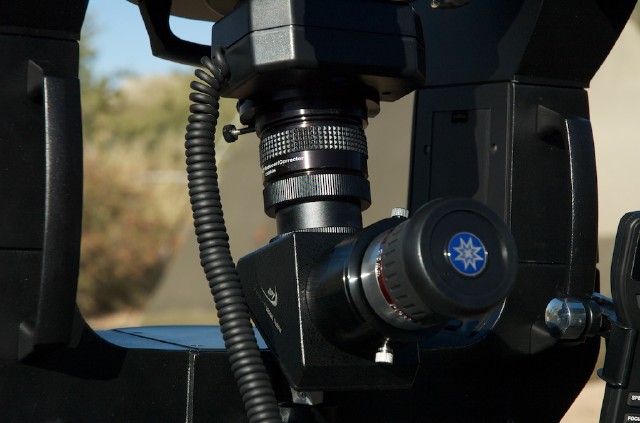
Here you can see the Antares focal reducer attached between the Microfocuser and a Meade #777 Off-Axis Guider. In this configuration, the maximum altitude would be about 65°, depending on the camera attached to the Off-Axis Guider.
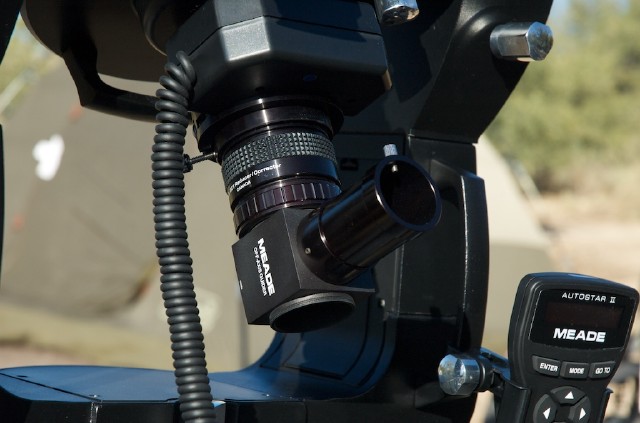
Here you can see the Meade focal reducer attached between the Microfocuser and a Meade #777 Off-Axis Guider. In this configuration, the maximum altitude would be about 65°, depending on the camera attached to the Off-Axis Guider.
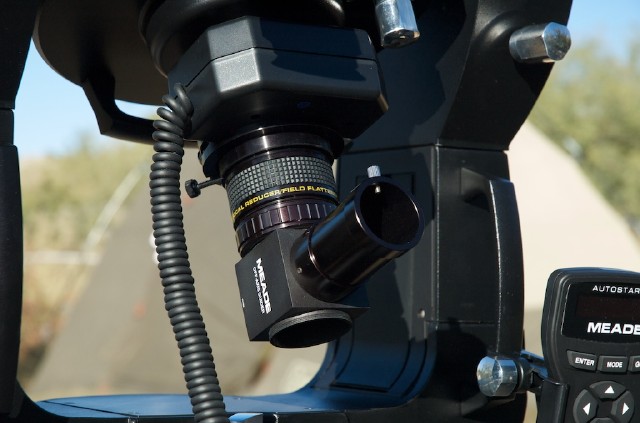
For the tests reported here, I did not use the Off-Axis Guider. I will sometime in the future, and I'll report back with the results. However, since my 8" LX200-ACF is currently used in the Alt/Az position (as I don't have a wedge), the need for off-axis guiding is pretty much eliminated due to field rotation on exposures longer than 3-5 minutes (I don't have a field-derotator).
I first did some visual tests with the focal reducers on the 8" LX200-ACF.
I attached the Meade focal reducer to the Microfocuser and the 2" star diagonal to the reducer and inserted the Meade Series 5000 26mm eyepiece. I then aimed the telescope at the Double Cluster. However, I was unable to reach a focus. I tried several other eyepieces without being able to reach a focus with any of them. Since I could not focus, I terminated testing of the Meade focal reducer with the 8" LX200-ACF. I did not try it without the Microfocuser; nor did I try any astrophotography with it. I had focus problems with the Meade focal reducer on the 8" LX90-ACF as well. I have received a couple of reports that a bad batch of focal reducers was shipped last year. Perhaps mine is one of that batch. I will be returning the Meade focal reducer to OPT. It was provided as an "evaluation unit".
I then attached the Antares focal reducer to the Microfocuser and the 2" star diagonal to the reducer and inserted the Meade Series 5000 26mm eyepiece. I then aimed the telescope at the Double Cluster. I could reach a focus. Both clusters were visible in the 26mm FOV. There was some distortion at the edge of the field of view. With a 30mm eyepiece, both clusters were easily seen in the FOV with only minimal distortion at the FOV edge. When viewing the Pleiades in the 30mm eyepiece, the main stars were just visible in the FOV. With a 50mm eyepiece, all the stars were easily visible; but there was more edge distortion. The M31 galaxy was impressive in the 30mm eyepiece. Both companion galaxies were visible in the same FOV.
For visual use with the 8" LX200-ACF, the Antares focal reducer can be effectively used on large and/or faint objects. The expanded field of view and the faster f/ ratio can make for impressive views of many objects.
Next, I did some astrophotography tests with the Antares focal reducer. I attached my Nikon D70 DSLR to a prime focus adapter and inserted it into the 2" star diagonal.
My first target was the Double Cluster. Here is what the camera captured (30 second exposure, ISO 1600) without the focal reducer. Only one of the clusters is visible.
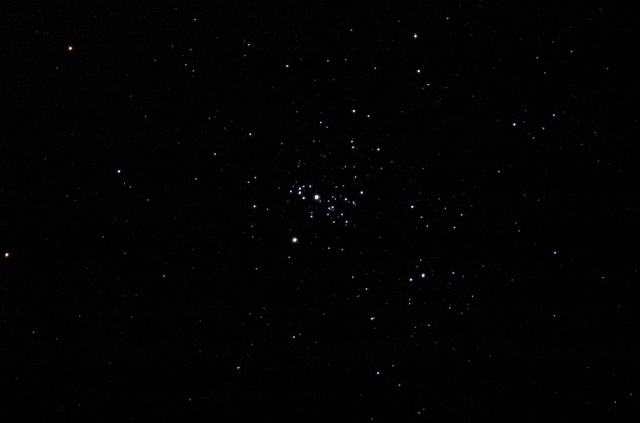
And here is the image (60 seconds, ISO 1600) with the Antares focal reducer. Both clusters are visible.
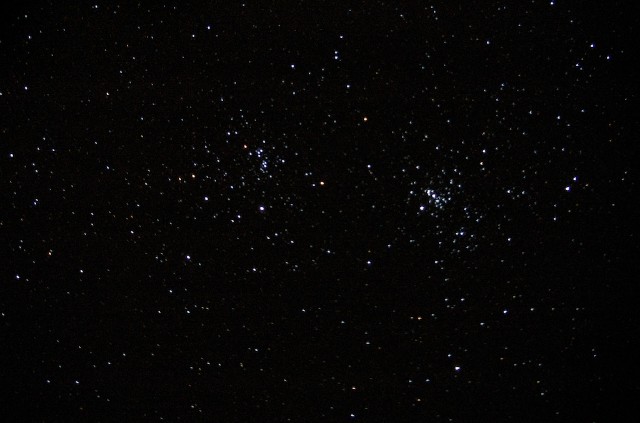
Here is M31, the Great Andromeda Galaxy (3 minute exposure, ISO 1600), without the reducer.
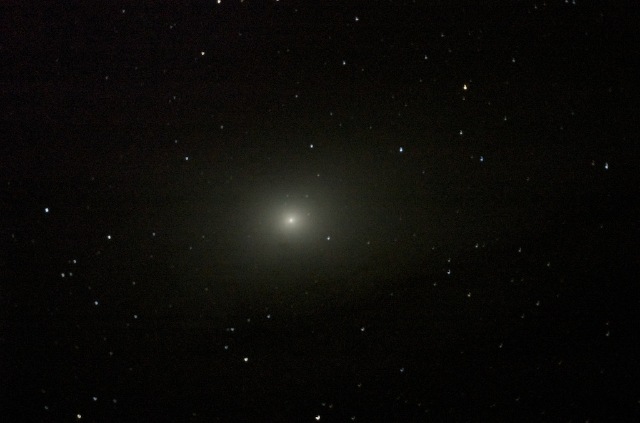
And here is M31, the Great Andromeda Galaxy (also a 3 minute exposure, ISO 1600), with the reducer.
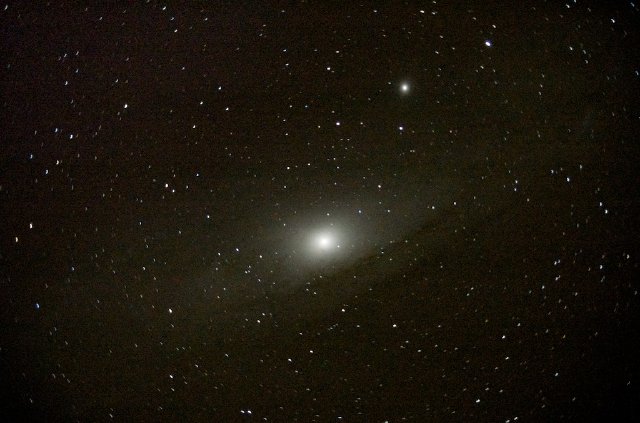
That's a rather dramatic improvement! I should mention that all the images used here are single frame, with no image stacking. Noise Reduction was enabled on the D70 DSLR. The raw images were edited in Aperture.
Here is the Pleiades with the Antares focal reducer (5 minute exposure, ISO 1600).
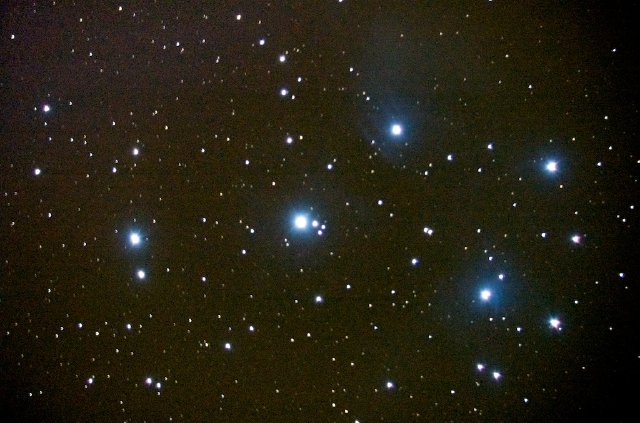
Some nebulosity is visible around some of the stars.
This is M1, the Crab Nebula, with the Antares focal reducer (5 minute exposure, ISO 1600).
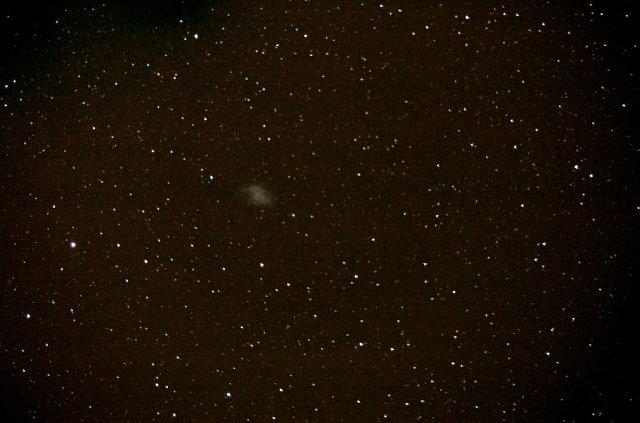
And the last astrophotography test that I did on this visit to Oracle Observatory was M42, the Great Nebula in Orion with the Antares focal reducer (5 minute exposure, ISO 1600).
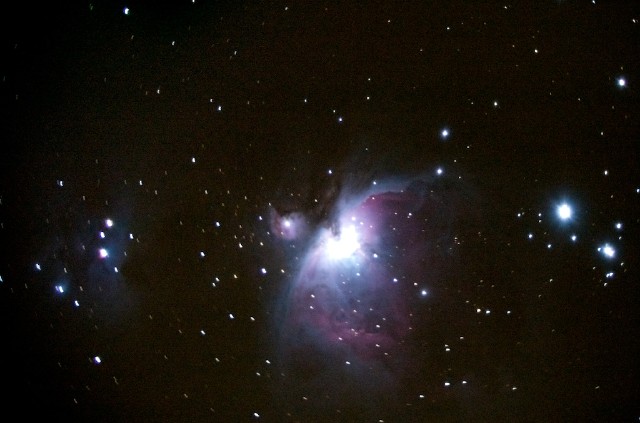
Pretty amazing for a single frame image, even with some minor field rotation visible near the edge of the field.
I am very pleased with the Antares focal reducer. It is a high quality optical accessory that will provide excellent views and amazing astrophotographs of many objects when used with an appropriate telescope. I will be purchasing this evaluation unit from OPT.
Go to the LX200-ACF Table of Contents.
Go to Mike & Laurraine's Home Page.